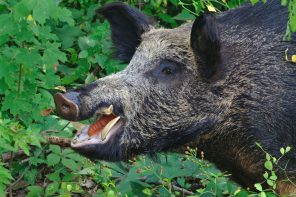Holding an absinthe tasting seems fraught with peril. What happens if the guests start hallucinating? Or if they cut off their ears, like absinthe addict Vincent van Gogh? Or, worst of all, if they wreck the furniture, like Ernest Hemingway: “Got tight on absinthe last night and did knife tricks. Great success shooting the knife into the piano.”
All these things are possible, if absinthe’s fearsome reputation is to be believed. Not only is it highly alcoholic – it can be 72% abv – but it’s made from distilled herbs, including wormwood. This bitter herb, which has an active ingredient called thujone, has been blamed for everything from hallucinations to madness.
And, contrary to popular belief, many modern absinthes are similar to those banned a century ago.
Absinthe renaissance
The absinthe bans were gradually lifted in Europe and Australia, beginning in the 1990s and proceeding rapidly after 2000. Since then, there’s been an absinthe renaissance as distillers and chemists work to revive old French and Swiss recipes, which typically include herbs such as fennel, hyssop, angelica and melissa. One such is chemist Ted Breaux, whose Jade absinthes are created from old recipes brewed in the original alembics (distillate chambers or “stills”).
Clearly, it’s time for a tasting. Despite my concerns for the piano, I invited an opera singer, an artist, writers and a theatre director to approximate a Belle Epoque salon and help me discover whether absinthe truly is a creative muse, as playwright Oscar Wilde believed. For authenticity, the soiree was held in bohemian squalor (my flat), handily near a hospital.
Also along were Gaye Valttila and Joop van Heusden from Alexamo, the distributor of Lemercier Abisinthe, which is made from an original recipe. Ms Valttila prepared the drinks for us using equipment that looked like alchemical paraphernalia.
Absinthe glasses are tall and thick, with a reservoir at the base for the spirit. An ornate slotted spoon is laid across the top, holding a sugar cube. Water is dripped on the sugar from an absinthe fountain, which is an ice-filled glass enclosure with taps. Once enough water has dripped into it, the absinthe “louches”, which means it turns a milky green colour. It’s like making a potion.
“Absinthe began as a herbal elixir to eradicate worms from the system, hence ‘wormwood’,” explained Ms Valttila.
Origins disputed
Wormwood distillations have been recorded in Bohemia (the Czech Republic) since the 1500s, but they appeared in France and Switzerland around the 1750s. Modern absinthe dates from 1792, when Dr Pierre Ordinaire commercialised it as a cure-all. Henri-Louis Pernod founded the Pernod Fils absinthe company in 1805, after seeing its aperitif potential. Absinthe’s moment truly came with the 1840s Algerian wars, when French soldiers drank it as a prophylactic against disease. They brought it home, and by the 1860s Parisian cafes had established 5:00pm as l’heure verte – ‘the green hour’.
“Then came the phylloxera bug that wiped out the grape crop, so wine was too expensive,” continued Ms Valttila. Absinthe became wildly popular and, soon enough, counterfeits began to appear. “People started using poisons to create the colour and the louche effect.”
Dr Valentin Magnan warned in the 1860s of a condition he called “absinthism”, characterised by addiction, convulsions and hallucinations. These also happen to be symptoms of both alcoholism and poisoning, but Dr Magnan’s views influenced attitudes against absinthe. A sensational Swiss murder in 1905 was also blamed on absinthe and, as the French wine industry was recovering at much the same time, there were strong commercial interests stacked against the drink. The French banned absinthe in 1915. But were they right to?
Potent effects
“A glass of absinthe makes you feel clearer, brings clarity,” said van Heusden. “That’s why the artists drank it – they felt it inspired them and they could drink more.”
Alas, the absinthe didn’t inspire our salon to great things; everyone was too attracted to the absinthe ritual to do anything creative. We didn’t even get a bad limerick out of it. On the other hand, nobody threw knives into the piano, either.
As I sampled more absinthe over the week, however, the liquorice taste grew on me and I had a small glass every evening. There was a price to pay: I developed awful, wretched insomnia, where I was aware of being desperately tired, but too wired and alert to sleep. It occurred to me there might be a connection to my absinthe sampling, despite all the modern literature insisting that absinthe is innocuous and unfairly demonised. Maybe all those artists loved absinthe because it kept them going all night. Maybe van Gogh’s Starry Night exists because he was getting a good look at the night sky. And maybe if I cut my ear off, I might get some sleep.
I contacted Professor David Presti, a neurobiologist from the University of California at Berkeley, an expert on drugs and the brain. “Thujone definitely has a stimulant effect,” he said. It’s possible the historic problem with absinthe was that the stimulant masked the alcohol, leading people to drink too much. People were getting wasted.”
The effects of the other herbs in absinthe are unknown, as is whether the combined effects are greater than the sum of their parts. Since Professor Presti suggested I stop drinking at night, sleep has returned. But I’m all for absinthe – its taste and its Harry Potter-like preparation.
But if it is to be revived, we should recover the old ways of drinking. Professor Presti opposes the modern practice of shots: “I consider that absinthe abuse. It’s very destructive – and very disrespectful to absinthe’s history.”
What’s needed is a dripping fountain to dilute the absinthe, a dusk ‘green hour’, and lots of people gathering to talk art, creativity and big ideas. In other words, what’s needed is the bright face of the Green Fairy.
A version of this article first appeared in The Age.




